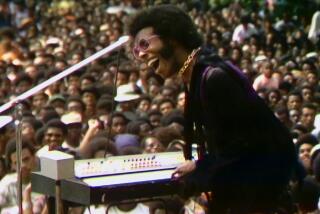Lost time:
BEFORE the Z-Boys exploded from Dogtown’s dirty alleys and torturous waves to recharge skateboarding with raw style and cocky attitude, their reluctant leader, a skinny blond kid named Jay Adams, lived the innocent and bronzed existence of a true California beach boy. He cut barefoot across cracked driveways on a clay-wheeled plank, carved comfortably along waves peeling off Malibu Point and piled into the family wagon for safaris through Baja, Mexico.
Last summer, the now legendary surfer-skater immersed himself in those images as he sat in a cell in Santa Ana Jail, awaiting sentencing after having signed a plea agreement on federal drug-related charges. He drew on memories of his childhood freedom to write the captions for “Jay Boy,” a new book of 82 photographs taken by his stepfather, Kent Sherwood.
The stark black-and-white images show Adams and his childhood friends -- including Dogtowners Tony Alva, Wentzle Ruml and Shogo Kubo -- at play along the empty streets and beaches of a rundown Venice and Santa Monica, places now marked by bustling promenades and overcrowded surf breaks. Nostalgia ranks high among the emotions that the collection evokes.
“As a kid, Jay was always a free spirit,” Sherwood said recently. “But he started getting in trouble later on. I don’t know why.”
A self-taught photographer who made a hobby of shooting, developing and printing voluminously, Sherwood was always lugging around a beat-up Russian-made 35-millimeter single-lens reflex and a medium-format Roloflex. Along with Adams’ late mother, Philaine Romero, to whom the book is dedicated, Sherwood raised Adams from early on -- just after the boy lost his heroin-addict father to prison -- and introduced him to surfing and skating.
Sherwood, 65, was as surprised as anyone that a bunch of “old dusty family photos” could become a book. “I was just lucky I had a very good subject,” he said, speaking from his Inglewood factory, Foam Matrix, where he taps years of surfboard-building experience to craft state-of-the-art rocket fins and wings. “Jay was very photogenic, and he was always moving, so I had to be ready.”
“Jay Boy” is a selection from several hundred color and black-and-white negatives and prints Sherwood gave to Adams and his bride, Alisha, on their wedding day, May 14, 2005. A few months later, Adams approached old friend and New York-based photographer Glen E. Friedman, whose mid-’70s SkateBoarder magazine images, along with the photojournalism of C.R. Stecyk III, helped canonize Dogtown’s Z-Boys. With their aggressive, flowing surf style, the boys rewrote the rules of skateboarding across the Southland’s wide-open schoolyards and bone-dry swimming pools.
“Jay called me and said, ‘I got all these photos, can you help me make a book?’ ” Friedman explained. He also worked on the award-winning “Dogtown and Z-Boys” documentary, but he’s better known for his own photo books that chronicled emerging punk rock, hip-hop and skate scenes. “Honestly, I didn’t have that much confidence in the idea -- doing a book is not easy and everybody thinks that their photos are better than they really are. But I told him, ‘Send me everything, and I’ll take a look.’ ”
The fading past
FRIEDMAN said he was instantly captivated by Sherwood’s shots of a golden boy from a vanished era. With Adams’ nod, Friedman assumed control of the project, editing and designing the book as his Burning Flags Press teamed up with Concrete Wave Editions and Pool King Publications to release 3,000 copies on Oct. 31. Friedman added that all the interested parties -- most of whom are surfers and skaters themselves -- were so honored to be part of a book about one of their heroes that they worked at cut rates and agreed to donate 100% of the profit, plus $1 per book sold, to Adams’ family: his wife and their baby girl, Venice, who was born May 6.
Alisha Adams expects that the modest windfall will help her chip away at mounting legal bills and recharge her husband’s books while he awaits sentencing.
“I’m just thankful that people love Jay the way they do,” she said recently, her voice trailing off. “I’m just praying that he just gets time served.”
On the wrong side of the glass in the jailhouse visitors’ booth last month, Adams, 45, looked nothing like the pure and playful shaggy blond surf grommet in the photos. He seemed believable as a criminal: khaki jumpsuit bathed in artificial light, brown hair slicked back, goatee well-trimmed and arms sleeved in tattoos -- including punk-rock Black Flag bars, a portrait of Charles Manson and a small but conspicuous swastika -- that run to each wrist. More indelible black ink across his knuckles: “TEAM PAIN.”
Arrested by federal agents in November 2005 at his home on the North Shore of Oahu, Hawaii, Adams -- on parole at the time from burglary and possession charges dating to the late ‘90s -- was charged with playing the middleman on a big-time drug deal between California and Hawaii during the summer of 2004. His lawyer, Robin Yanes of Marina del Rey, said his hope is that a federal judge will release him on time-served, though a life sentence is still possible.
Adams wiped down the jailhouse phone before speaking. “The other guys [involved in the drug deal] got arrested about nine months before me,” he said. “So I kind of knew that it might happen. But I got myself clean, I married my wife and started going to church, and my whole life had turned around again. It was all good.
“It’s weird,” he continued, “because the day I got arrested, I was telling [my wife], ‘You know, I never really do anything anymore that I can get arrested for. I probably won’t ever get arrested again. But that thing that happened before [we met] could come back and bite me.’ And it did later that day. [The feds] showed up at my house.”
His voice was calm, his blue eyes relaxed.
“Being away from my wife and new baby -- that’s hard,” he said. “I’ve seen my baby through a window. But I haven’t got to pick her up or smell her or make any contact. Another thing that’s hard to deal with is that the time I’m doing now -- I’m not sure what the final outcome will be until I’m sentenced.”
Yanes said he would likely be sentenced early next year.
Adams first became familiar with the inside of a jail cell in the early ‘80s, when he served six months in connection with the death of a man he had fought and left beaten on the street in front of Hollywood’s Okie Dog. (The man was then kicked to death by another.) Hard time, however, didn’t find him until nearly two decades later, when he served 2 1/2 years of a 10-year sentence in three Hawaiian prisons on drug-related charges. Much of it stemmed, Adams said, from a heroin addiction he developed in the mid-’90s when, in the span of about 18 months, his half-brother was slain, his grandmother passed away, his biological father committed suicide, and his mother lost a prolonged, painful fight with cancer as he watched from her bedside.
All the while, though, and since before he could drive, Adams made a living doing what he had always loved: surfing and skateboarding with his friends. His enviable early life has drawn the admiration of both veterans and upstarts for the last three decades. They saw him as a skateboarder’s skateboarder: a raw talent without all the bad-boy ego of a pro.
This side of Adams -- funny, approachable and just plain cool -- contrasts starkly with his jailhouse jumpsuit and faded tattoos, but it surfaces easily with talk of surfing and skating. And it’s clear that it was this man, the surfer-skater with the blessed childhood, not the criminal awaiting sentencing in federal court, who wrote the captions for “Jay Boy.” They appear in his own handwriting and add his humor, gratitude and insight to the photo book.
As he awaits his sentencing, Adams said, he spends most of his time reading the Bible, listening to Christian radio and drawing. He also responds to fan mail from around the world.
What he tells fans, he said, is: “I have nobody to blame but myself, that I’ve made mistakes and there are things I wouldn’t want anybody else to copy. I’m not trying to influence people in a negative way.... I know my motives are right when I write kids and tell them not to do drugs.”
His main message, he said, is to learn from your mistakes. “Even if you get away with something, it can come back and bite you down the line. So it’s better off just not doing them in the first place. For some of us, it takes a little longer to learn that, you know?”
More to Read
Sign up for our Book Club newsletter
Get the latest news, events and more from the Los Angeles Times Book Club, and help us get L.A. reading and talking.
You may occasionally receive promotional content from the Los Angeles Times.





